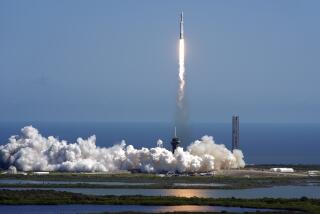It’s all systems go for Europa
NASA announced plans Wednesday to embark on a mammoth 20-year project to send a spacecraft to Jupiter’s ice-covered moon Europa as its next flagship mission to search for life elsewhere in the solar system.
The mission, which could cost as much as $3 billion, will be managed by the Jet Propulsion Laboratory in La Canada Flintridge. It will focus on the possibility that in the gigantic ocean thought to be hidden under the moon’s thick cover of ice is a habitable zone where rudimentary forms of life could exist.
The probe will launch in 2020 in tandem with another orbiter built by the European Space Agency that will focus on Jupiter’s largest moon, Ganymede.
The Europa mission’s primary scientific goal will be to produce a global map in preparation for a journey many years in the future that would land on the moon.
Using radar and other devices, the probe will try to verify the thickness of the ice sheet and determine the presence of the ocean covering the 2,000-mile diameter moon.
“Europa is tremendously exciting,” said Jim Green, director of the Planetary Sciences Division at NASA. “It may have more water underground than the Earth.”
NASA’s decision to go to Europa is the culmination of years of debate, involving intense lobbying by scientists, space professionals and enthusiasts who have long been fascinated by the romantic image of watery life forms swimming under the surface ice.
“There is no question that Europa has the attractiveness that there could be an ocean below the ice,” said Charles Elachi, director of JPL. “Therefore, there could be life under there.”
What makes Europa so important, said Robert Pappalardo, a senior research scientist at JPL, is that “icy satellites are the most common potentially habitable environment in the outer solar system,” and therefore could be common throughout the universe.
Understanding how they function, and whether they are indeed a good home for life, is key to answering the “are we alone” question.
NASA’s decision came down to a contest between Europa and a return to Saturn’s giant moon Titan, which had been visited by the Cassini-Huygens mission in 2005.
That joint mission by NASA and ESA uncovered evidence of vast hydrocarbon lakes and methane rainstorms on the moon.
Life as we understand it could not survive the harsh conditions on Titan, the sixth of Saturn’s seven major moons. But scientists think it may serve as a model of the early Earth, before it developed into a livable world.
The decision, Green said, did not come down to what mission was more important.
“We believe Europa is more technologically ready,” he said.
Europa, the second of Jupiter’s four large moons, has been studied much longer than Titan. The moon was visited in the 1970s by Voyager and a pair of Pioneer spacecraft. The bulk of scientific knowledge was gleaned from NASA’s Galileo mission, which orbited Jupiter for eight years beginning in 1995.
Even though Europa won the competition to be the next decade’s focus in the search for life, “Titan will not be forgotten,” Green said. “There is nothing like Titan” elsewhere in the solar system, he said.
For JPL, the announcement that it will manage the Europa mission continues its preeminence among NASA centers for mounting journeys to the outer planets.
In the long term, Elachi said, it will guarantee that JPL remains viable and healthy, with a steady workforce of about 5,000 people.
The number of jobs will probably not increase significantly because engineers and scientists working on the Cassini project could be shifted to the new mission.
Plans call for a launch in 2020, followed by a nearly six-year cruise to the Jupiter system, culminating in an intensive, three-year study of Jupiter’s moons Europa, Ganymede, Io and Callisto.
The American probe is named Jupiter Europa Orbiter, while the European one is called the Jupiter Ganymede Orbiter, in recognition of the initial targets of the spacecraft.
Each will spend a year studying the primary targets before traveling to other satellites. The European orbiter will travel separately on its own rocket.
Elachi thinks this will enable the two orbiters to gather twice the information. They may also communicate with each other and divide up work assignments.
Europa is so far from the sun that its surface temperature averages minus 276 degrees Fahrenheit, but the subsurface oceanic temperatures could be much warmer because of heating from the moon’s core, as well as from tidal forces caused by gravity from Jupiter.
Normally, radiation from Jupiter would be lethal to any form of life. But the ice layer could serve as a protective shield, Elachi said.
The Europa mission could conceivably bring other moons to prominence, just as Cassini elevated Titan.
Ganymede, the ESA probe’s initial target, is also thought to have an icy surface that may conceal a watery ocean, possibly 140 miles below.
Ganymede is the largest moon in the solar system and the only one with a magnetic field around it, like Earth’s.
The long-term problem for explorers of Europa and the other icy moons will be finding a method of digging through the ice layer to the ocean.
The Phoenix mission to Mars that ended weeks ago was the first robotic lander to dig under the surface of another planet to locate ice. Its scoop penetrated only a few centimeters.
But on Europa, the probe would need to churn through miles of ice as hard as rock, unless the lander was mobile enough to find fissures leading to the interior.
--
--
(BEGIN TEXT OF INFOBOX)
An icy moon
Europa is one of Jupiter’s 49 named moons, and one of the four largest, which are known as the Galilean satellites. It is slightly smaller than Earth’s moon. Other facts:
Discovery: By Galileo in 1610
Average distance from Jupiter: 416,940 miles
Length of year/rotation period around Jupiter: 3.5 Earth days
Composition: Thought to have an iron core, a rocky mantle and ice layer atop a surface ocean of salty water
Source: NASA. Graphics reporting by Julie Sheer






